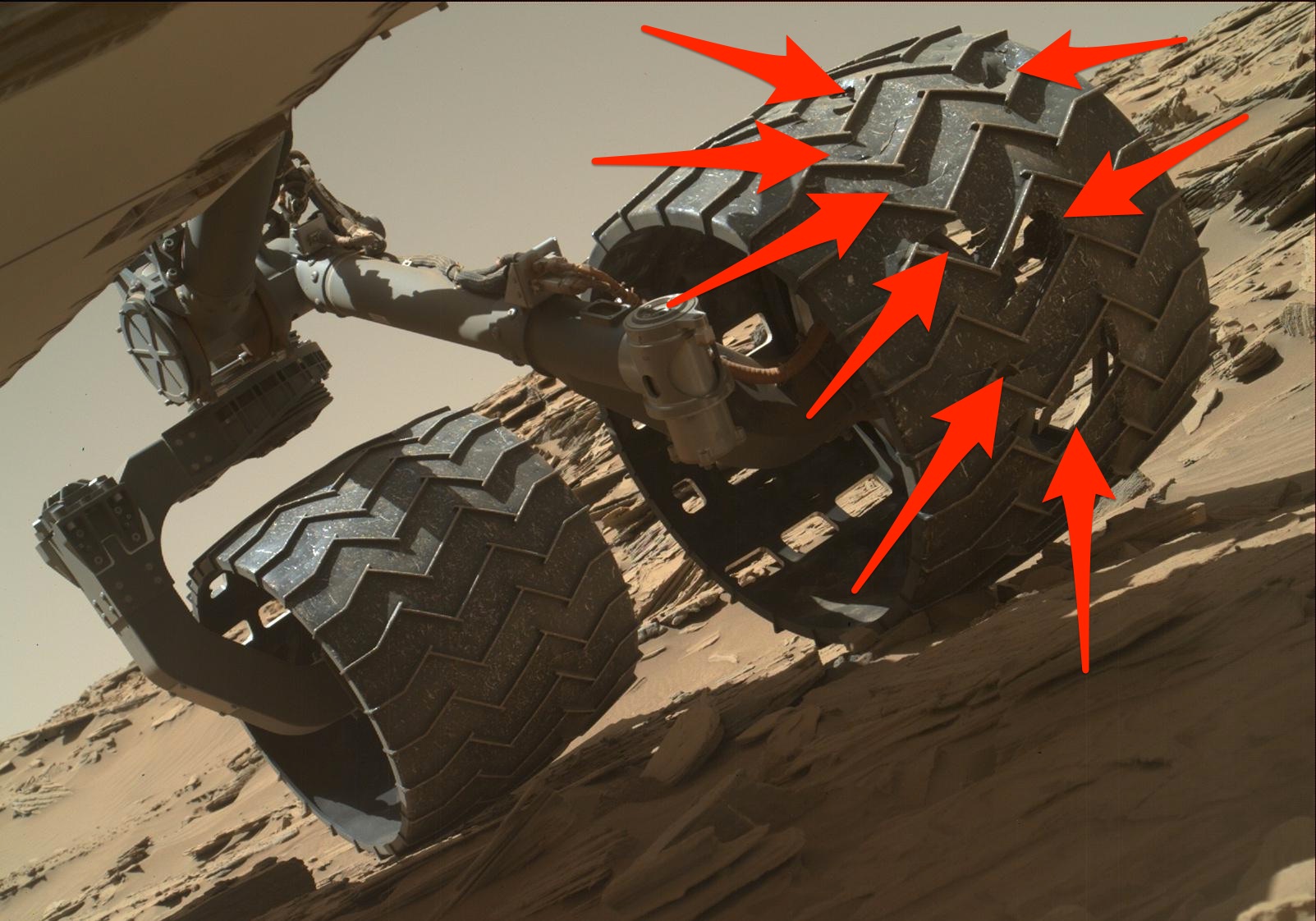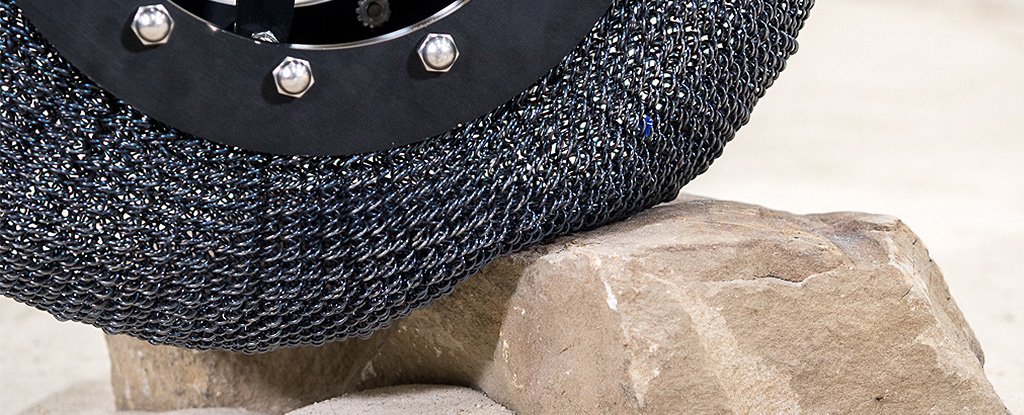Mars chews up our wheels and spits them out. Take NASA's one-ton, car-size, nuclear-powered Mars Curiosity robot: After just a year of cautious 0.09-mile-per-hour (144 metres) roving, small rocks began ripping large holes in its tyres. However, NASA engineers have reinvented the wheel into a form that may one day conquer Mars.
They have created a nearly
invincible tyre made of woven-mesh metal that "remembers" its ideal
shape and immediately springs back into form after taking a beating. The
design, highlighted in a recent feature by the space agency, is rooted at NASA
Glenn Research Center in Cleveland, Ohio. Engineer Colin Creager and his
colleagues initially built a woven-mesh wheel made out of spring steel. It
gripped soft sand well and supported a lot of weight, yet kept hitting a major
snag.
"We always came across
this one problem of where the tyres would... get dents in them," Creager
said in a NASA video.
Then Creager bumped into
materials scientist Santo Padula, who suggested using a shape-memory alloy – a
super-elastic metal that pops back into place after intense strain.
"Since then, we've been
collaborating .. to come up with this new tyre that we think is really going to
revolutionise planetary rover tyres and potentially even tyres for Earth,
too," Creager said.
NASA has been developing
space-grade tyres since the 1960s, starting with its moon-landing program. Those
efforts led to mesh wheels on the Lunar Roving Vehicles, which astronauts drove
during the Apollo 15, 16, and 17 missions. Stiff metal strips in and on the
tyres helped keep the LRVs moving on soft moon dust, yet also stood up to the
punishment of small rocks.
The space agency later set
its sights on Mars, spurring development in off-planet wheels. Yet the list of
requirements for roving the red planet is daunting:
 |
| Damage on Curiosity's wheels as of April 18, 2016 (NASA/JPL-Caltech/MSSS; Business Insider) |
All-terrain: Mars is covered in sand, gravel, and boulders yet also littered with jagged rocks.
Lightweight: It costs
roughly $US30,000 per pound to land something on Mars, so every ounce counts.
Durable: Solar or nuclear
energy can help missions last more than a decade on the red planet.
Able to survive wild
temperature swings: Inflated rubber tyres wouldn't last on a nearly airless
world with temperatures that can shift from nearly -200 degrees to 70 degrees
Fahrenheit (-130 to -57 Celsius) in some locations. To handle scaling a
veritable mountain, Curiosity's designers made 20-inch-high aluminium wheels. They
are toughened by stiff internal rings and outer rims, can grip the soil with
V-shaped treads, and absorb bumps and shocks using flexible internal spokes.
Yet mission controllers
began noticing worrisome dents, holes, and tears in those tyres in 2013 – about
a year into the mission. Today Curiosity is instructed to avoid small pointy
rocks, limiting damage, but the wheels continue to degrade.
"When the current rover
wheel damage occurred, we thought it was worth taking a look at that wheel and
adapting it for the future," Creager told Business Insider.
After years of research, the
team settled on a nickel-titanium (NiTi) alloy and figured out the best process
to form and treat it. Spring steel can only withstand 0.3 percent of strain
(the distance the atoms in the metal shift) before it gets dented and the metal
crystals permanently rearrange. The NiTi alloy in question, however, can suffer
up to 10 percent strain – about 30 times better elasticity.
As a result, the new wheels
boast some impressive stats: They can bear nearly 10 times the weight of Curiosity's
wheels, function between -202 and 194°F (-130 and 90°C), have better grip over
rocks and sand, and can climb slopes about 23 percent steeper.
"We [can] actually
deform this all the way down to the axle and have it return to shape, which we
could never even contemplate in a conventional-metal system," Padula said
of the new spring tyre in another NASA video.
Phillip Abel, a mechanical
systems expert at NASA Glenn, said the key to the tyre's performance are the
stretchy bonds of the crystal structure in shape-memory alloys.
"With super-elastic
materials, what you're doing is .. storing the energy of deformation in the
[crystal structure]. All of the atoms are more or less where they were,"
Abel told Business Insider about the crystal structure shifts.
“The alloy, at the
temperatures we're seeing, is always in its 'return to my original shape' mode.
So after you deform it, it pops back to its original crystal structure. In the
toughest test to date, the wheels aced 10 kilometres of driving – more than
half the total mileage of Curiosity on Mars – on punishing simulated terrain. The
rim was a little dinged up, but the spring mesh tyre was like brand-new,"
Creager said, adding the caveat that the test did not occur at blistering
Martian conditions. "In theory, they should work, but NASA JPL is building
a cryogenic test chamber to verify operation at cold temperatures," he
said.
Future and heavier Mars
rover missions are in the works, putting pressure on NASA to redevelop its tyres.
A rover that's nearly identical to Curiosity yet heavier, called Mars 2020, is
scheduled to launch in just a few years.
That mission could be a boon
in the search for alien life, since it may drill samples that another,
similarly built rover can later help launch to Earth. Curiosity wasn't
outfitted with the newer wheels, since they weren't developed before its
launch, and Creager said it's probably too late to put them on NASA's upcoming
Mars 2020 rover. (It takes a gruelling number of tests to prove the viability
of a wheel for use on a space mission.)
"You can buy
nickel-titanium alloy off the shelf, but you can't just use it on Mars. There's
a treatment process," Creager said. “Even with years of work, he added,
"there's still a lot we need to understand."
However, they could be ready
to roll for the Mars-sample-return mission in 2024. The wheel's applications
aren't limited only to the red planet, though; Creager, Abel, and Padula are
working with Goodyear to put them on Earth-based vehicles.
So far, one they attached to
a Jeep hugged around rocks without inflicting any damage to the spring tyre.
"I could definitely see
it being used for any application where you're driving off-road, and the risk
of a puncture and a flat is a big deal, like with a military vehicle,"
Creager said.
"But I would love to
see this technology branching off to passenger vehicles."
This article was originally
published by Business Insider.

